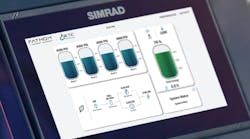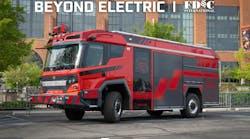These days, with fire departments hampered by tight budgets, training (particularly large-scale exercises) may get cut in order to staff enough personnel. However, the effectiveness of computer-based simulations has begun to catch up with the promise.
Departments no longer have to settle for a PowerPoint presentation that’s long on talk and short on action, as a number of commercial companies have ventured into the firefighter training field, even creating Personal Computer (PC) simulations that can help train firefighters to battle wildfires for substantially less money than has ever been possible before. In this first article in a new series on wildfire simulations, we take a closer look at a representative sample of commercial companies that offer affordable products that can provide realistic wildfire training to even the smallest fire departments.
Fire Studio
Digital Combustion, which makes Fire Studio, was started by two firefighters, Rich Merritt and Doug Prochnow 12 years ago. While working at the Costa Mesa Fire Department in California they saw a need for realistic fire simulation.
“Fire Studio is an All-Hazard emergency incident simulation production tool,” said Rich Merritt, president of Digital Combustion. “It is designed to allow you the freedom of creating custom scenarios that reflect possible emergency situations in your area.”
Operational efficiency coincides with effective training and the most effective training is that which is applicable to the department, according to Merritt. “Firefighters are routinely required to make decisions based solely on what they see and hear,” he said. “Fire Studio 5 [the latest version] provides all of the tools necessary to make simulations as true to real life as any simulation can be, while remaining affordable.”
And it can be customized by firefighters to fit specific scenarios, as well. “Fire Studio allows you to import your own photos or digital video to design scenarios personalized to your locality,” Merritt confirmed. “You can create All-Hazard emergency simulations based on buildings, target hazards, wildland urban interface, industrial facilities and aircraft – all from your area. Once you have imported your background images, you can add any combination of Fire Studio’s provided fire, smoke, explosions, hazmat elements, sounds and more.”
You can add a smoke column and then change the size, color, angle, speed and density in real time and the latest version includes exclusive video elements (i.e. victims, firefighters, moving flags etc.) that can be added into any simulation for an even higher level of realism. This allows trainers to have all the tools necessary to create a complete emergency incident for simulation exercises or classroom presentations.
“Damage can be added to your background images as the fire progresses, with black charring increasing on both vegetation and structures over time, which works well in wildfire simulations,” Merritt pointed out. “The ability to use a virtual camera to pan and zoom across your scene even allows you to show a moving camera view from an approaching unit.”
And with the real-time clock, the pressure is on! “When building your scenarios, you have complete control over how those simulations will be played,” Merritt added. “You are able to create a timed simulation that will progress based on specific timeframes, or let the instructor have complete control, determining when and where the fire will spread, and when it will be extinguished. Navigation can also be placed in the control of the student by using onscreen navigation icons.”
Viewing can be partitioned as well, showing different members of a crew different views of an incident. “Users who need a higher level of sophistication in their training exercises have chosen to use CommLink, our network control module,” explained Merritt. “CommLink allows you to remotely control multiple copies of Fire Studio over a network. Instead of participants all viewing the same scene, the instructor can assign them into different command positions and have them view the incident from their angle or perspective at the scene. As an example, these views could show different locations of a large wildfire incident.”
Fire Studio provides competitively priced effective training without requiring a technical degree or programming knowledge. It is designed to develop better decision-making skills, and to ultimately improve incident outcome and reduce firefighter injuries and death.
Who uses Fire Studio so far? “Fire departments, academies, industrial facilities, the military, and other government agencies from around the world are currently using Fire Studio for professional training,” said Merritt.
As far as pricing is concerned, the Player Edition of Fire Studio 5, which will allow the user to run pre-made scenarios, is only $230, but if you want to create your own scenarios, you need to step up to the Instructor Edition, which runs $895 a copy. To operate a multi-player versions with multiple computers participating, you would also need to purchase the Commlink Network Control Module for $1,775, and for departments that want to purchase a full multi-player system, prices range from $3,231 up to $15,740, depending on the number of computers involved.
For more information on Fire Studio and Digital Combustion, visit www.digitalcombustion.com.
StageIT
Action Training Systems (ATS), located in Poulsbo, WA, has been around since 1988, when they began producing quality multimedia productions on VHS tapes. They’ve always used actual firefighters or EMS personnel in filming their programs. Their StageIT Emergency Response Simulator is a professional compositing and editing tool that allows you to create or re-create fire, hazmat or emergency response stages of an incident and present them for testing and evaluation. StageIT uses a file and folder structure with the familiar Windows-style interface to make navigation easier. It comes with an extensive library of images and effects along with a printed user manual. Director of Sales and Marketing Ken Bostwick, a former volunteer firefighter with five years experience, shares some insights on this realistic simulator.
Realism is important to ATS. “When you’re creating these simulations, you’re talking about [a fire department’s] strategy and tactics,” said Bostwick. “There are some universal principles, but you also have to look at your available personnel and equipment. These influence your strategy and tactics.”
The software is flexible, allowing the importing of actual photos or videos from a department’s operating area. “If you’ve got pictures, if you’ve got video clips, you can put those right in, then it’s just a matter of building it,” Bostwick confirmed. “You can build something as a relatively simple simulation if you don’t have a lot of time, or you can create something that’s pretty complex. It scales with what you have the time or the ability to do.”
Bostwick says that a lot of it comes down to the experience and knowledge of the instructor, because that’s who is the brains of the simulator. “There’s no content in [the simulator], instructors are building it, so if they have some good wildland pictures that they took at a scene, they could probably do a pretty good job creating or re-creating an incident with it,” he says.
And if you feel uncomfortable with the prospect of putting together a computer training simulation, StageIT is fairly easy to use. “Firefighters or EMS personnel just want a tool that is going to help them instruct better or train better, they are generally not in love with computers per se,” Bostwick affirmed. “With StageIT’s file and folder design, you simply drag and drop effects. So, when you know a couple of basic principles about StageIT it’s pretty easy to work with.”
Another nice feature of StageIT is the ability to use scenarios in presentations. “The separate stages of a StageIT scenario are published as an independent Windows Media Video [.wmv] files automatically, which can be taken out of StageIT and inserted into other programs, like a PowerPoint presentation,” said Bostwick. “I had one guy who used StageIT to replace photos of smoke in a PowerPoint presentation he’d used for years with little movies showing those different smoke types. He said, ‘Everybody thinks I’m so cool by doing that, but it really wasn’t that hard to do!’”
“If an instructor wants to use the software to present simulations in a classroom or on a standalone computer they only need the Instructor Module which is $1,499,” said Bostwick. “The Effects Module [$499] adds more effects and the StageIT Student Module [$149] is only needed if they want to network in other computers and be able to present simulations to students remotely.”
Bostwick believes tighter budgets are bringing the training back in house, so trainers say, “What can I do as an instructor here to have a good, interesting and viable training situation for my people?” He adds that Seattle had a mass-casualty training exercise a few years ago, where they were bringing in different agencies to participate. “It was about a $1 million event,” Bostwick said. “So what could your department do with an extra million dollars?
Visit www.action-training.com/product.aspx?training=StageIT_Emergency_Response_Simulator&pid=541 for more information on StageIT and Action Training Systems.
XVR
Based in Boise, ID, Bravo Delta, Inc, is the parent company of Total Immersion Simulation Systems (TISS), purveyors of a unique fire simulator that uses animation to allow users to model a wide variety of situations, including wildfires. The TISS environments are powered by E-sembles’ XVR [short for eXercise Virtual Reality and eXam Virtual Reality] training software. Through the use of XVR, they offer 2D or 3D visuals for their simulated environments. Their simulator packages are scalable from a single PC program to custom-made environments with immersion rooms or dome projection. Dennis Hulbert, a partner in Bravo Delta and a 38-year veteran of the fire service who retired as a Regional Aviation Officer with US Forest Service, provides some insight on this unique simulator.
“Our action-based scenarios use the latest technology to support ‘active learning’ [the learner is not restricted to follow a predefined learning path and not restricted to reading and observation] by immersing students into operational and tactical learning domains where, as individuals or working teams, they engage in interactive role playing with other trainees and educators,” Hulbert explained. “An active learner can interact with other trainees and the educator in the simulated environment and can learn by experimenting in the learning domain.”
Trainees have a variety of ways to experience the simulation. “Using a joystick, XVR allows one or more incident response professionals to walk, drive or fly around in the simulated reality of an incident,” Hulbert explained. “While the students are distracted by surrounding noise and confusion, they are expected to focus on their tasks and to set priorities.”
And instructors have total control over the simulations they are running. “Instructors have the ability to incrementally increase the complexity of the scenario or, more importantly, freeze the scenario at any moment to give individual feedback or to discuss alternative decisions with the trainee(s),” said Hulbert. “TISS also has the capability to link remotely located participants, thereby giving them the ability to interact with others who are actively involved with the simulated exercise.”
Unlike many other simulators that require the input of actual photos or videos, XVR provides everything you need, but you had better have a fairly high-performance system and at least 50 GBytes of room on your hard disk, because you’re going to need it! In addition to Windows 7 Operating System and a Logitech Extreme 3D Pro joystick, the requirements for a computer system to run XVR are as follows:
Desktop PC
Processor: Intel Xeon quad-core Processor (3.20 GHz, 8 MB cache, 1066-MHz memory)
Graphics card: NVIDIA GeForce GTS 450
Monitors: Minimal height resolution of 1024
Laptop PC
Processor: Intel Core i7-640M Processor
Internal memory: 8 GB 1333-MHz
Graphics card: NVIDIA Quadro FX 1800M 1GB
Disk Drive: 500-GB 7200-rpm SATA II
XVR pricing depends on the scope of a department’s training program: for a single virtual environment, a user would pay $2,100 per PC per year; for four virtual environments it would be $8,400 per PC per year; and for those wanting to model all virtual environments, the price goes up to $10,500 per year per PC.
To see more about this product, visit www.bravodeltainc.com.
MIKE ARCHER is an author, wildfire consultant, systems engineer, and public speaker who has been interviewed by CBS News, KABC-TV, USA Today, and the Associated Press on wildfire topics, and has been part of a delegation testifying before government bodies (including Congress and the California Senate) on fire-related issues. He runs the Wildfire News of the Day blog and Firebomber Publications.





